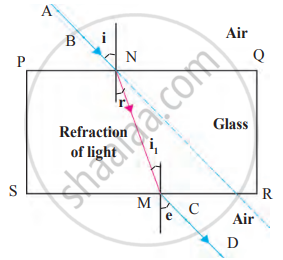Advertisements
Advertisements
प्रश्न
Explain why, though both a plane mirror and a sheet of paper reflect light but we can see the image of our face in a plane mirror but not in a sheet of paper.
उत्तर
This is because there occurs regular reflection from a plane mirror, which has a smooth surface. Since the particles of the smooth surface are facing one direction, a beam of parallel light rays falling on it is reflected as a beam of parallel light rays in one direction only. These rays meet when produced backwards to form a virtual image of the light source.
However, in the case of a rough paper, a parallel beam of incident light is reflected in different directions (diffused reflection). So, the light rays don't meet to form an image of the object.
APPEARS IN
संबंधित प्रश्न
| Column I | Column II | Column III | |
| 1 | Dispersion | Long-sightedness | Twinkling of stars |
| 2 | Refraction | Splitting of white light into component colours | Convex lens |
| 3 | Hypermetropia | Change in the direction of the ray of light due to change in medium | Spectrum of seven colours |
Name the phenomenon responsible for the following effect:
When we sit in front of a plane mirror and write with our right hand, if appears in the mirror that we are writing with the left hand.
Which type of reflection of light leads to the formation of images?
A ray of light when passes from glass to air, bends towards the normal.
What is the cause of refraction of light when it passes from one medium to another?
Observe the given figure and name the following.

| Ray AB | |
| Ray NM | |
| Ray MD | |
| ∠ r |
Numerical problems.
The speed of light in water is 2.25 × 108 ms–1. If the speed of light in vacuum is 3 × 108 ms–1, calculate the refractive index of water.
Mirage is an example of refraction and the total internal reflection of light.
A water tank appears shallower when it is viewed from the top due to refraction.
Under what circumstances there won’t be any refraction of light when it enters from one medium to another?
